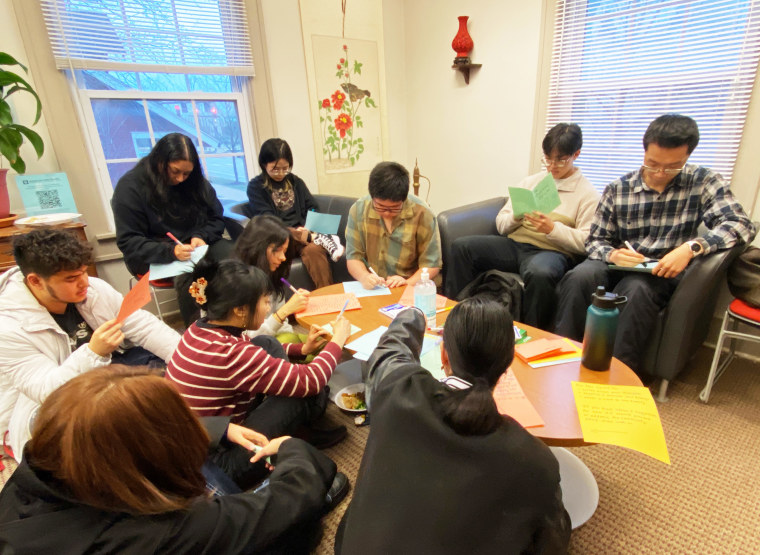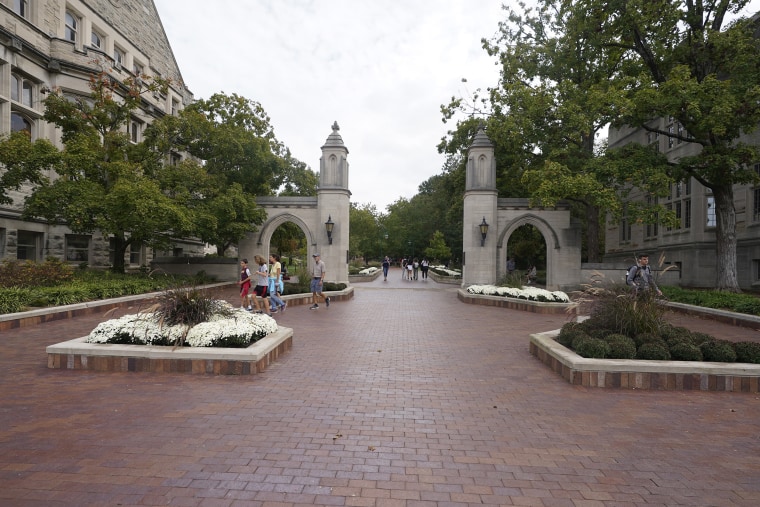Asian Americans at Indiana University Bloomington are reeling after an 18-year-old student was stabbed on a city transit bus last Wednesday, allegedly because of her identity. But they don’t feel that they’ve received sufficient support.
Since the incident, a sense of shock has rippled through the school’s Asian community. The suspect, Billie Davis, told the Bloomington Police Department that she targeted the student, who survived the incident, for “being Chinese,” adding “it would be one less person to blow up our country,” court documents show. With fears around their safety amplified, Asian American students who spoke to NBC News said they’ve been disappointed in the response from both those outside the Asian community and the school administration, who made their first statements around the attack two days afterward.
“It’s very tiring for the Asian community to be doing all the work,” Audrey Lee, a senior, said. “I think a lot of Asian Americans internalize the feeling that if they do kind of speak out, when these situations happen, they’re going to be viewed as crazy or overreacting.”
Mara Yankey, senior media relations consultant for Indiana University, responded in an email that the victim’s request for privacy “limits what IU or other local officials can say publicly.”
“But it does not diminish our university’s commitment to provide support to them, their family, and — of course — to our students, faculty and staff,” she wrote.
The student, whose identity has not been released, was allegedly waiting for the bus door to open when a fellow passenger struck her repeatedly in the head before walking out, police said in a statement. While the suspect told police that she targeted the victim due to her race, Jeff Kehr, Monroe County chief deputy prosecuting attorney, previously said in an interview that the state does not have a hate crime law that would alter the severity of the charges.
The students say that conversations around the incident have been active among the Asian Americans on campus. But they admit that when stepping outside of their safe spaces, they often feel a sense of loneliness. Zhang, a sophomore and resident adviser for the school’s Asian American Thematic Community, said he isn’t confident that those outside the Asian community are all aware of the violent attack. And it’s this lack of awareness, the students say, that shows the administration could be doing more to promote education and solidarity around Asian American issues not only to the student body, but also to the surrounding community.

“There’s not really any advocacy group in the community that makes Asian issues very visible. I think the administration should make that more of a priority, just expanding their own diversity and inclusion efforts to the community, because the students can’t do that alone,” Lee said.
On campus, Lee said she has also had several uncomfortable experiences with microaggressions and rarely do non-Asian bystanders speak out or offer support. There’s been other cases, both Lee and Zhang said, in which the Asian community’s concerns have been minimized, devalued or completely dismissed by their peers. And without efforts to mitigate racism and promote an understanding around the Asian population, many have felt the looming potential for more serious instances of racism, such as the attack.
Karen Cheng, a senior at the university and the president of the school’s Asian American Association, noted a similar sense of fear. As an Asian American woman, she said, public safety concerns predate the tragedy. The city of Bloomington itself has a small but sizable Asian population, making up just over 10% of its residents. But the community is also flanked by some areas with white supremacist activity, something many Asian American students are aware of, Cheng said.
In the 1920s, an estimated 1 in 3 white protestant males in the state were dues-paying members of the Ku Klux Klan, according to the Washington Post. Over a century later, the Southern Poverty Law Center tracked 15 active hate groups throughout Indiana.
Race-related violence against Asian students also lives in the city’s not-so distant past as former IU student Benjamin Smith, a vocal white supremacist who had disseminated white power pamphlets on campus and across the city, murdered 26-year-old doctoral student Won-Joon Yoon in 1999 outside the Korean United Methodist Church. Smith, who had previously been sought in a series of shootings earlier that year that targeted Black, Jewish and Asian people, fatally shot himself the same night.
And many continue to have uncomfortable encounters with racism, and some say it’s an ever-lingering anxiety as they move through their college years. Cheng recounted an incident at a grocery store in December that left her shaken.
“I shop there all the time, students go there all the time, too,” she said. “And this angry, old white man almost bumped into me and then he was like, ‘Excuse you, nasty Asian.’”
The students say that it has been up to Asian Americans themselves, including faculty members of Asian descent, student groups and loved ones to begin the healing process.
“One of my residents asked me … if we could all write letters to the victim even though we don’t know what her name is,” Zhang said. “We just want to show support, make sure she knows that there’s people out here advocating for her.”
They praised the university’s Asian Culture Center for releasing a statement shortly after the attack and organizing a night of open discussion last week, inviting the campus community members to talk about their emotions and write letters to the victim. And many took it upon themselves to offer rides to those who felt unsafe and check in on their friends’ emotional and mental health.
In many cases, the Asian community’s strength is empowering, said Cheng, whose organization boasts more than 200 members.
“We are the only ones who truly understand,” she said. “We can almost save ourselves, in a way.”
For now, it seems the Asian American population will continue to do what they do best and find comfort in one another.
“There’s a lot of people here who are just so willing to help even if they aren’t your best friends,” Zhang said of the Asian American community. “We all have a mutual understanding of this fear and have all at one point experienced it, or know someone who has experienced it.”
